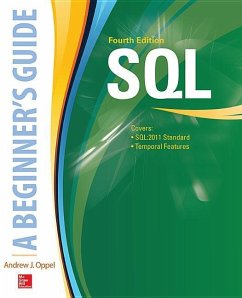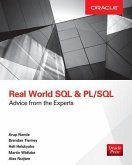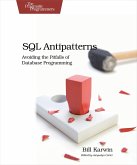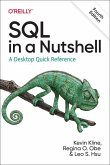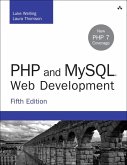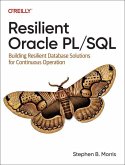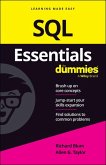Andy Oppel
Sql: A Beginner's Guide, Fourth Edition
Andy Oppel
Sql: A Beginner's Guide, Fourth Edition
- Broschiertes Buch
- Merkliste
- Auf die Merkliste
- Bewerten Bewerten
- Teilen
- Produkt teilen
- Produkterinnerung
- Produkterinnerung
This fully revised, self-paced learning tool lays out all the steps necessary to get started writing SQL programs quickly and easily.
Andere Kunden interessierten sich auch für
![Real World SQL and Pl/Sql: Advice from the Experts Real World SQL and Pl/Sql: Advice from the Experts]() Arup NandaReal World SQL and Pl/Sql: Advice from the Experts56,99 €
Arup NandaReal World SQL and Pl/Sql: Advice from the Experts56,99 €![SQL Antipatterns SQL Antipatterns]() Bill KarwinSQL Antipatterns34,99 €
Bill KarwinSQL Antipatterns34,99 €![Xquery Xquery]() Priscilla WalmsleyXquery56,99 €
Priscilla WalmsleyXquery56,99 €![SQL in a Nutshell SQL in a Nutshell]() Kevin KlineSQL in a Nutshell72,99 €
Kevin KlineSQL in a Nutshell72,99 €![PHP and MySQL Web Development PHP and MySQL Web Development]() Luke WellingPHP and MySQL Web Development54,99 €
Luke WellingPHP and MySQL Web Development54,99 €![Resilient Oracle PL/SQL Resilient Oracle PL/SQL]() Stephen MorrisResilient Oracle PL/SQL61,99 €
Stephen MorrisResilient Oracle PL/SQL61,99 €![SQL Essentials for Dummies SQL Essentials for Dummies]() Richard BlumSQL Essentials for Dummies15,99 €
Richard BlumSQL Essentials for Dummies15,99 €-
-
This fully revised, self-paced learning tool lays out all the steps necessary to get started writing SQL programs quickly and easily.
Produktdetails
- Produktdetails
- Beginner's Guide
- Verlag: McGraw-Hill Education - Europe
- 4 ed
- Seitenzahl: 560
- Erscheinungstermin: 22. Oktober 2015
- Englisch
- Abmessung: 231mm x 187mm x 32mm
- Gewicht: 836g
- ISBN-13: 9780071842594
- ISBN-10: 0071842594
- Artikelnr.: 43154576
- Herstellerkennzeichnung
- Libri GmbH
- Europaallee 1
- 36244 Bad Hersfeld
- gpsr@libri.de
- Beginner's Guide
- Verlag: McGraw-Hill Education - Europe
- 4 ed
- Seitenzahl: 560
- Erscheinungstermin: 22. Oktober 2015
- Englisch
- Abmessung: 231mm x 187mm x 32mm
- Gewicht: 836g
- ISBN-13: 9780071842594
- ISBN-10: 0071842594
- Artikelnr.: 43154576
- Herstellerkennzeichnung
- Libri GmbH
- Europaallee 1
- 36244 Bad Hersfeld
- gpsr@libri.de
Andrew J. (Andy) Oppel is a proud graduate of The Boys' Latin School of Maryland and of Transylvania University (Lexington, KY) where he earned a BA in computer science in 1974. Since then he has been continuously employed in a wide variety of information technology positions, including programmer, programmer/analyst, systems architect, project manager, senior database administrator, database group manager, consultant, database designer, and data architect. In addition, he has been a part-time instructor with the University of California (Berkeley) Extension for over 20 years, and received the Honored Instructor Award for the year 2000. His teaching work included developing three courses for UC Extension, "Concepts of Database Management Systems", "Introduction to Relational Database Management Systems", and "Data Modeling and Database Design." He also earned his Oracle 9i Database Associate certification in 2003. He is currently employed as a senior data modeler for Blue Shield of California. Aside from computer systems, Andy enjoys music (guitar and vocals), amateur radio (Pacific Division Vice Director, American Radio Relay League) and soccer (Referee Instructor, U.S. Soccer). Andy has designed and implemented hundreds of databases for a wide range of applications, including medical research, banking, insurance, apparel manufacturing, telecommunications, wireless communications, and human resources. He is the author of Databases Demystified (McGraw-Hill/Osborne, 2004) and SQL Demystified (McGraw-Hill/Osborne, 2005). His database product experience includes IMS, DB2, Sybase, Microsoft SQL Server, Microsoft Access, MySQL, and Oracle (versions 7, 8, 8i, 9i, and 10g).
Part I: SQL Databases
Chapter 1. Introduction to Relational Databases and SQL
Chapter 2. Working with the SQL Environment
Chapter 3. Creating and Altering Tables
Chapter 4. Enforcing Data Integrity
Chapter 5. Creating SQL Views
Chapter 6. Managing Database Security
Part II: Data Access and Modification
Chapter 7. Querying Data
Chapter 8. Modifying Data
Chapter 9. Using Predicates
Chapter 10. Working with Functions and Value Expressions
Chapter 11. Accessing Multiple Tables
Chapter 12. Using Subqueries to Access and Modify Data
Chapter 13. Working with Temporal Data
Part III: Creating SQL Invoked Routings
Chapter 14. Creating SQL Invoked Routines
Chapter 15. Creating SQL Triggers
Chapter 16. Using SQL Servers
Chapter 17. Managing SQL Transactions
Chapter 18. Accessing SQL Data from Your Host Program
Chapter 19. Working with XML Data
Part IV: Appendices
Appendix A. Answers to Self Tests
Appendix B. Keywords
Chapter 1. Introduction to Relational Databases and SQL
Chapter 2. Working with the SQL Environment
Chapter 3. Creating and Altering Tables
Chapter 4. Enforcing Data Integrity
Chapter 5. Creating SQL Views
Chapter 6. Managing Database Security
Part II: Data Access and Modification
Chapter 7. Querying Data
Chapter 8. Modifying Data
Chapter 9. Using Predicates
Chapter 10. Working with Functions and Value Expressions
Chapter 11. Accessing Multiple Tables
Chapter 12. Using Subqueries to Access and Modify Data
Chapter 13. Working with Temporal Data
Part III: Creating SQL Invoked Routings
Chapter 14. Creating SQL Invoked Routines
Chapter 15. Creating SQL Triggers
Chapter 16. Using SQL Servers
Chapter 17. Managing SQL Transactions
Chapter 18. Accessing SQL Data from Your Host Program
Chapter 19. Working with XML Data
Part IV: Appendices
Appendix A. Answers to Self Tests
Appendix B. Keywords
Part I: SQL Databases
Chapter 1. Introduction to Relational Databases and SQL
Chapter 2. Working with the SQL Environment
Chapter 3. Creating and Altering Tables
Chapter 4. Enforcing Data Integrity
Chapter 5. Creating SQL Views
Chapter 6. Managing Database Security
Part II: Data Access and Modification
Chapter 7. Querying Data
Chapter 8. Modifying Data
Chapter 9. Using Predicates
Chapter 10. Working with Functions and Value Expressions
Chapter 11. Accessing Multiple Tables
Chapter 12. Using Subqueries to Access and Modify Data
Chapter 13. Working with Temporal Data
Part III: Creating SQL Invoked Routings
Chapter 14. Creating SQL Invoked Routines
Chapter 15. Creating SQL Triggers
Chapter 16. Using SQL Servers
Chapter 17. Managing SQL Transactions
Chapter 18. Accessing SQL Data from Your Host Program
Chapter 19. Working with XML Data
Part IV: Appendices
Appendix A. Answers to Self Tests
Appendix B. Keywords
Chapter 1. Introduction to Relational Databases and SQL
Chapter 2. Working with the SQL Environment
Chapter 3. Creating and Altering Tables
Chapter 4. Enforcing Data Integrity
Chapter 5. Creating SQL Views
Chapter 6. Managing Database Security
Part II: Data Access and Modification
Chapter 7. Querying Data
Chapter 8. Modifying Data
Chapter 9. Using Predicates
Chapter 10. Working with Functions and Value Expressions
Chapter 11. Accessing Multiple Tables
Chapter 12. Using Subqueries to Access and Modify Data
Chapter 13. Working with Temporal Data
Part III: Creating SQL Invoked Routings
Chapter 14. Creating SQL Invoked Routines
Chapter 15. Creating SQL Triggers
Chapter 16. Using SQL Servers
Chapter 17. Managing SQL Transactions
Chapter 18. Accessing SQL Data from Your Host Program
Chapter 19. Working with XML Data
Part IV: Appendices
Appendix A. Answers to Self Tests
Appendix B. Keywords

